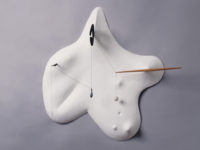Oving Architekten
Westerbork, The Netherlands
Between 1942 and 1945, nearly 107,000 Dutch and German Jews passed through Camp Westerbork, a detention facility in the northeast Netherlands. Trains, arriving like clockwork every Tuesday, transported detainees to extermination camps including Auschwitz-Birkenau and Sobibór. Little remains of Westerbork’s 100 or so buildings except, ironically, the green clapboard house that belonged to the camp’s commander.
In 2012, Dutch firm Oving Architekten won a competition to create a protective enclosure for this deteriorating monument to infamy, but wanted their contribution to dissolve into the background: “We tried to not make a building,” explains principal Francine Neerhof Oving. The architects devised a simple yet powerful solution, encasing the entire house in a glass and steel box. Everything—including the house’s narrow yard and front step—is locked away inside this pavilion, only accessible to visitors a few times throughout the year. In its vitrine-like glazed enclosure the house becomes a surreal object, hermetically sealed into a different time and place—a place, the architect says, “that remembers the tears.”















Post a comment to this article
Report Abusive Comment